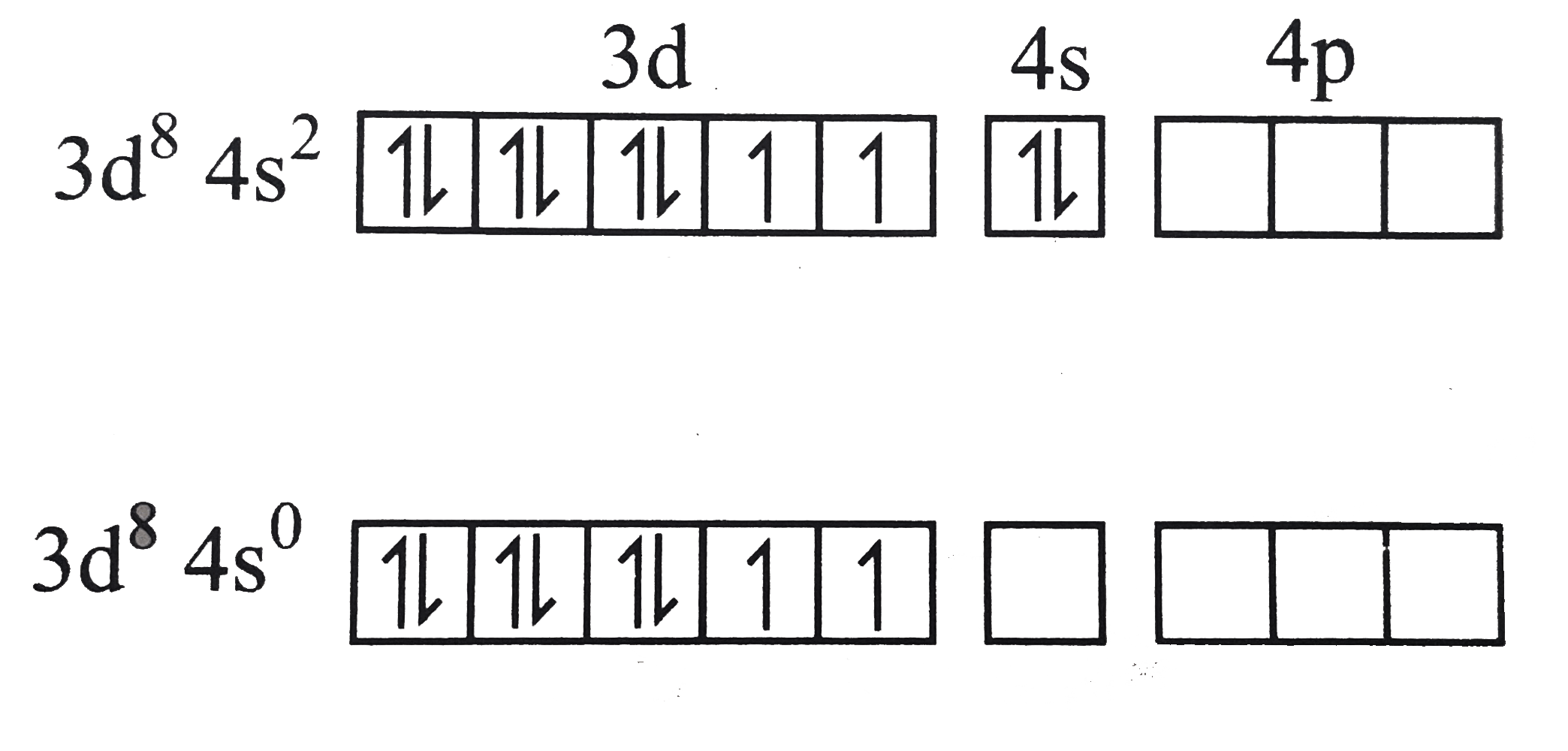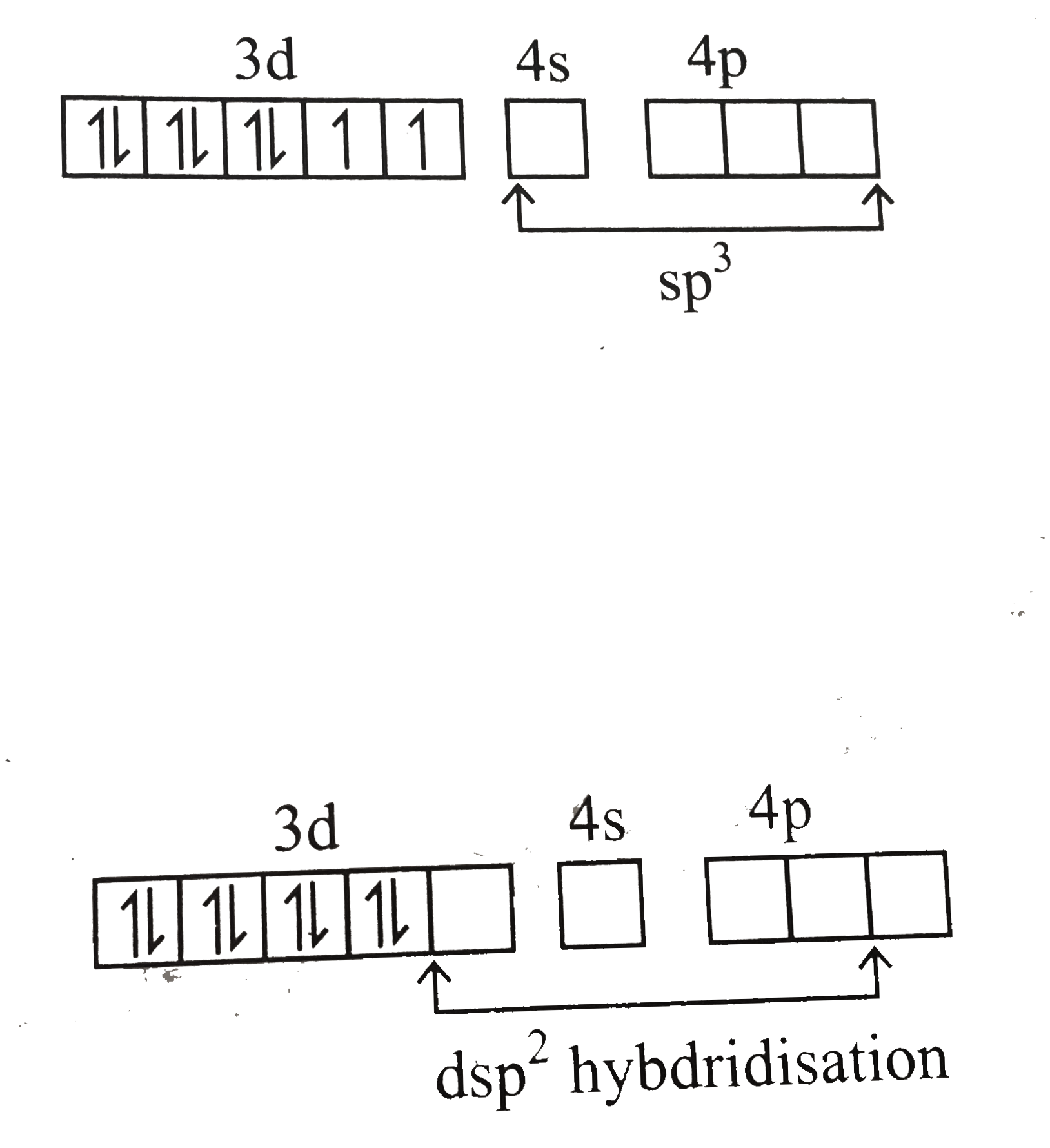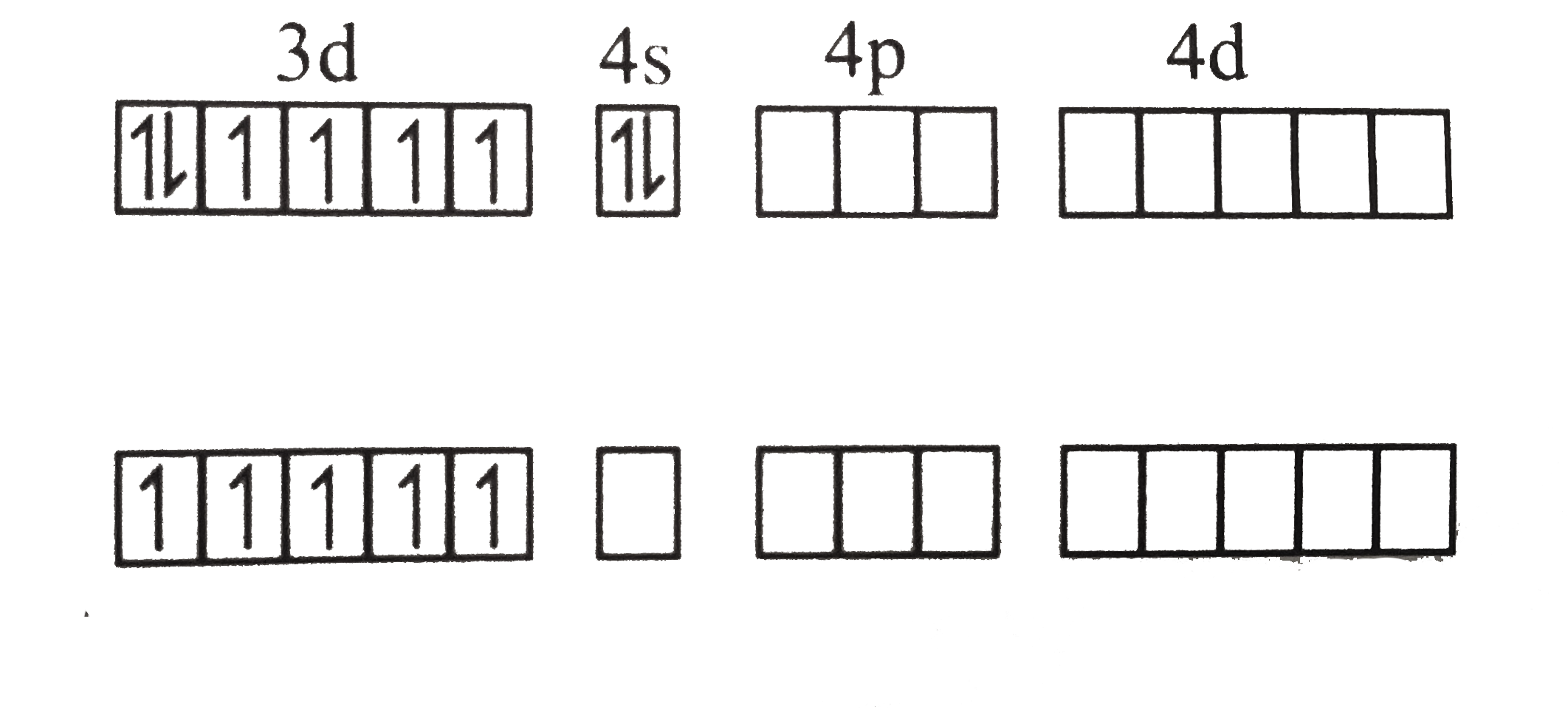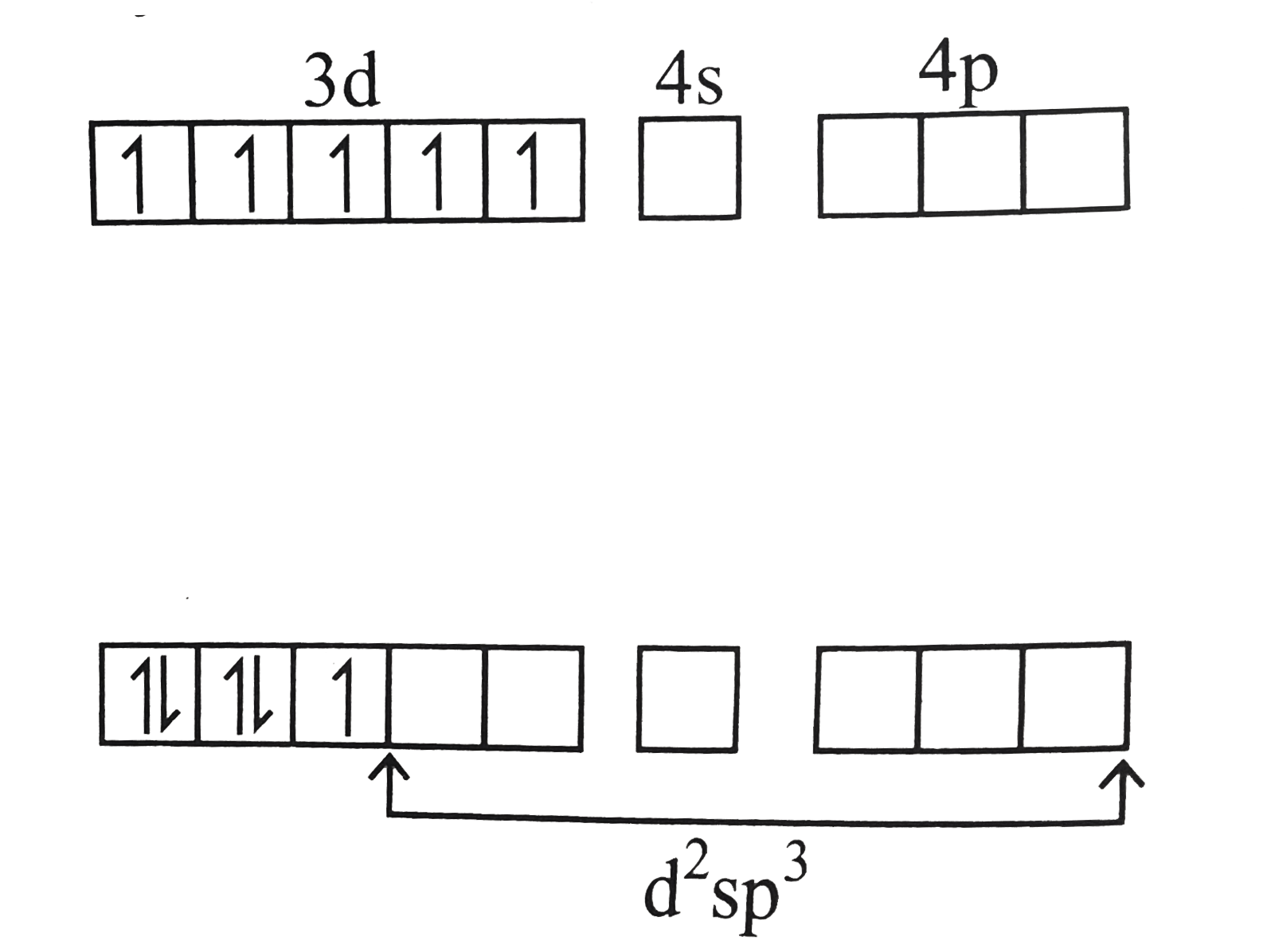Explain the following giving reasons
(a) [NiCI4]2− is tetrahedral and paramagnetic whereas [Ni(CN)4]2− is square plannar and dimagnetic
(b) [Fe(H2O)6]3+ ion is more paramagnetic than [Fe(CN)6]3− ion
(c ) Ni(CO)4 is tetrahedral while [Ni(CN)4]2− ion is square planar
(d) [Co(F6)]3− is a high spin complex whereas [Co(CN)6]3− ion is a low spin complex .
Video Solution
Text Solution
In the complex, [NiCI4]2 and [Ni(CN)4]2− oxidation state of Niis+2ion


Since CIΘ ion is weak field ligand electronic configuration of Ni2+ in [NiCI4]2− remains the same

Since Ni2+ in [NiCI4]2− ion is sp3 hybridised and have two unpaired electrons it is tetrahedral and paramagnetic
Since CNΘ ion is strong field ligand electronic configuration of Ni2+ in [Ni(CN)4]2− is

one electron from 3dx2−y2 orbital gets paired with that in 3dz2 ortbital Thus one d-orbital (3dx2−y2 orbital)becomesavailab≤fordsp^(2)hybrsationwhichgives□planar≥ometrywithn=0The[Ni(CN)_(4)]^(2-)isdiama≥ntic<br>(b)OξdationstateofFe∈[Fe(H_(2)O)_(6)]^(3+)ionis+3<br><imga≤ocr_imageload∈g=lazysrc=https://d10lpgp6xz60nq.cloudfront.net/physics_images/KSV_P2_CHM_C07_S01_049_S05.pngwh=80%mx-autosty≤=background:white;><br><imga≤ocr_imageload∈g=lazysrc=https://d10lpgp6xz60nq.cloudfront.net/physics_images/KSV_P2_CHM_C07_S01_049_S06.pngwh=80%mx-autosty≤=background:white;><br>SinceH_(2)Oisweakfieldligandnopair∈gofe≤ctronstakesplaceand<br><imga≤ocr_imageload∈g=lazysrc=https://d10lpgp6xz60nq.cloudfront.net/physics_images/KSV_P2_CHM_C07_S01_049_S07.pngwh=80%mx-autosty≤=background:white;><br>i.ethereare5uppairede≤ctronsn=5<br>Whereeas in [Fe(CN)6]3− oxidation state of Feis+3
Since CNΘ ion is strong field ligand pairing up of electrons in 3d orbitals takes place is
i.e. there is only one unpaired electron n=1
Since in [Fe(H2O)6_(6)]3+ ion number of unpaired electrons are more than [Fe(CN)6]3− ion,[Fe(H2O)6]3+
more is paramagnetic [Fe(CN)6]3− ion
(c ) In Ni(CO)4 oxidation state of Ni is zero
Since Co is strong field ligands hence pairing of electrons takes place
Because of sp3 hybridisation [Ni(CO)4] is tetrahedral In [Ni(CN)4]2 oxidation state of Niis+2
Since CNΘ is strong field which results in pairing up of electron present in 3dx2−y2 and 3ddx2−y2 becomes available for dsp2 hybridisation
(d) [CoF6]3− is a high spin complex wherese [Co(CN)6]3− is alow spin complex This can be explained as
Since FΘ ion is weak field ligand no pairing up of electrons present 3d orbital takes place Since there are four unpaired electrons [CoF6]3− is paramagnetic complex Since outer orbitals (i.e 4d) are involved it is also known as high spin or outer orbital complex
Oxalate generally behaves as a weak fiels ligand but with Co it behaves as a strong field ligand like NH3 and H2O
In [Co(CN)6]3− oxidation sate of Co is +3
Since CNΘ is a strong field ligands pairing of 3d electrons takes place n=0 Since inner d orbitals (3d) are involved in hybridistion (d2sp3) it is also known as low spin or inner orbital complex
In [COF6]3−,n=4 whereas in [Co(CN6]3−,n=0 hence [CoF6]3− is a high spin complex whereas [Co(CN)6]3− is a low spin complex .
|
Updated on:21/07/2023
Topper's Solved these Questions
- BOOK - CENGAGE CHEMISTRYCHAPTER - COORDINATION COMPOUNDSEXERCISE - Solved Examples42videos
COORDINATION COMPOUNDS
- BOOK - CENGAGE CHEMISTRYCHAPTER - COORDINATION COMPOUNDSEXERCISE - Ex 7.1 Subjective (Terminology)5videos
COORDINATION COMPOUNDS
- BOOK - CENGAGE CHEMISTRYCHAPTER - CHEMICAL KINETICSEXERCISE - Archives Subjective23videos
CHEMICAL KINETICS
- BOOK - CENGAGE CHEMISTRYCHAPTER - D AND F BLOCK ELEMENTSEXERCISE - Archives Subjective29videos
D AND F BLOCK ELEMENTS
Similar Questions
Knowledge Check
- Question 1 - Select One
The [Fe(CN)6]3− complex ion :
Aexhibits planar geometryBis diamagneticCshould be very stableDhas 2 unpaired electrons - Question 2 - Select One
The [Fe(CN)6]3− complex ion :
Aexhibits planar geometryBis diamagneticCshould be very stableDhas 2 unpaired electrons - Question 3 - Select One
The name of complex ion, [Fe(CN6)]3− is
ATricyanoferrate (III) ionBHexacyanidoferrate (III) ionCHexacyanoiron (III) ionDHexacyanitoferrate (III) ion
Account for the fact that [Ni(CO)4] has tetrahedral geometry whereas [Ni(CN)4]2− has square planar geometry.
View Solution[Fe(H2O)6]3+ is strongly paramagnetic whereas [Fe(CN)6]3− is weakly paramagnetic. Explain.
View Solution[Fe(H2O)6]3+ is strongly paramagnetic whereas [Fe(CN)6]3− is weakly paramagnetic. Explain.
View Solution[Fe(H2O6]3+ is strongly paramagnetic whereas [Fe(CN)6]3− is weakly paramagnetic. Explain.
View Solution[Cr(NH3)6]3+ is paramagnetic while [Ni(CN)4]2− is diamagnetic. Explain why?
View Solution

